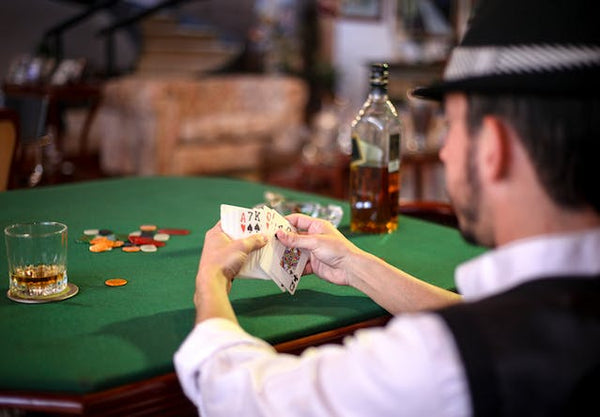minimum order amount $300 to checkout
Update CartPoker Cheating Device | Card Cheating Equipment

Brief Overview of the Popularity of Poker
Poker has emerged as one of the most popular card games globally, captivating millions of players across various demographics.
Its appeal lies in the combination of skill, strategy, and chance, making it both intellectually stimulating and thrilling.
From casual home games to high-stakes tournaments, poker has permeated popular culture through movies, television, and online platforms, further fueling its popularity.
Introduction to the Issue of Cheating in Poker
Despite its widespread appeal, poker is not immune to cheating, which undermines the integrity of the game and erodes players' trust.
Cheating in poker can take many forms, ranging from subtle manipulations of cards to sophisticated electronic devices designed to gain an unfair advantage.
The prevalence of cheating underscores the importance of awareness and vigilance among players to safeguard against dishonest practices.
Purpose of the Article
This article aims to shed light on the existence of poker cheating devices and provide readers with the knowledge and tools to protect themselves against such deceptive tactics.
By understanding the various types of cheating devices and learning to recognize the signs of their use, players can better safeguard the integrity of the game and ensure a fair playing environment for all.
Understanding Poker Cheating Devices
Definition of Poker Cheating Devices

Poker cheating devices refer to tools or mechanisms used to gain an unfair advantage in the game of poker by manipulating the outcome or information available to players.
These devices can range from simple markings on cards to sophisticated electronic gadgets, designed to deceive opponents and alter the course of the game in favor of the cheater.
Examples of Common Poker Cheating Devices
Marked Cards
Marked cards are altered playing cards with subtle markings or alterations that allow cheaters to identify specific cards during gameplay.
These markings can include tiny scratches, bends, or alterations to the design that are invisible to the naked eye but discernible through specific methods or tools.
Infrared Contact Lenses
Infrared contact lenses are specialized lenses worn by cheaters that allow them to see invisible markings on cards that are only visible under infrared light.
Cheaters can use these lenses to detect markings placed on the cards, giving them an unfair advantage in knowing the value of their opponents' hands.
Hidden Cameras and Earpieces
Cheaters may employ miniature cameras hidden in accessories or clothing to capture opponents' cards discreetly during gameplay.
The images captured by the cameras are then transmitted to an accomplice who communicates the information to the cheater through a hidden earpiece, allowing them to make informed decisions based on their opponents' hands.
Electronic Devices
With advancements in technology, electronic devices such as smartphones, tablets, or specialized poker calculators can be programmed to analyze opponents' cards or provide real-time assistance in decision-making.
Cheaters may use these devices to gain insights into their opponents' hands or to receive assistance in making strategic decisions, giving them an unfair advantage at the table.
Shuffling Machines
While shuffling machines are intended to ensure fairness in card distribution, they can be tampered with to manipulate the outcome of hands.
Cheaters may manipulate the shuffling process to stack the deck in favor of certain players or to arrange cards in a way that gives them an advantage during gameplay.
How Poker Cheating Devices Work

Mechanics Behind Each Type of Poker Cheating Device
Marked Cards
Marked cards work by altering the physical characteristics of playing cards to make them distinguishable to the cheater.
Common methods of marking cards include subtle scratches, bends, or alterations to the design that are visible only to the cheater or with the aid of special devices.
Cheaters can use these markings to identify specific cards during gameplay, giving them an unfair advantage over opponents.
Infrared Contact Lenses
Infrared contact lenses are specialized lenses that allow wearers to see markings on cards that are invisible to the naked eye but visible under infrared light.
Cheaters discreetly wear these lenses during gameplay, enabling them to detect infrared markings on the cards and gain insight into their opponents' hands.
The markings can be applied using invisible ink or other methods that are only visible under infrared light.
Hidden Cameras and Earpieces
Hidden cameras are concealed within accessories or clothing worn by the cheater and used to capture images of opponents' cards during gameplay.
The images captured by the cameras are then transmitted to an accomplice who communicates the information to the cheater through a hidden earpiece.
The cheater receives real-time updates on their opponents' hands, allowing them to make informed decisions and gain an unfair advantage at the table.
Electronic Devices
Electronic devices such as smartphones, tablets, or specialized poker calculators can be programmed to analyze opponents' cards or provide real-time assistance in decision-making.
Cheaters may use these devices to gain insights into their opponents' hands or receive assistance in making strategic decisions.
Some electronic devices are capable of scanning opponents' cards or analyzing gameplay patterns to provide the cheater with an advantage during gameplay.
Shuffling Machines
Shuffling machines are designed to randomize the order of cards before each hand to ensure fairness in gameplay.
Cheaters may tamper with shuffling machines to manipulate the outcome of hands by stacking the deck in favor of certain players.
This can be achieved by programming the shuffling machine to arrange cards in a specific order or by physically manipulating the machine to produce desired outcomes.
Illustrative Examples or Case Studies
Provide real-life examples or case studies of instances where poker cheating devices were used in actual gameplay.
Detail how the cheating devices were employed, the impact they had on the game, and any consequences faced by the cheaters.
Illustrate the importance of vigilance and proactive measures in detecting and preventing the use of cheating devices in poker.
Signs of Poker Cheating Devices
Observable Behaviors of Players Using Cheating Devices
Excessive Focus: Players using cheating devices may display an unusual level of concentration, constantly observing their opponents' actions and reactions with heightened intensity.
Erratic Behavior: Cheaters may exhibit erratic behavior such as sudden changes in demeanor, nervousness, or agitation, especially when confronted or questioned about their gameplay.
Unnatural Movements: Players using hidden devices like earpieces or concealed cameras may make subtle, unnatural movements, such as adjusting clothing or accessories frequently.
Unexplained Accessories: Players wearing bulky clothing or accessories that seem out of place, such as oversized hats or sunglasses indoors, may be concealing cheating devices.
Avoiding Scrutiny: Cheaters may actively avoid situations where their actions or equipment could be scrutinized, such as refusing to participate in card inspections or changing seats frequently.
Physical Signs to Look for in Cards and Equipment
Irregularities in Card Backs: Check for any irregularities or discrepancies in the design or texture of the card backs, which could indicate the presence of markings or alterations.
Visible Marks: Inspect cards under different lighting conditions and angles to detect any visible marks, scratches, or alterations that may have been made to distinguish specific cards.
Unusual Accessories: Examine players' accessories, such as sunglasses, hats, or jewelry, for hidden cameras, earpieces, or other electronic devices that could be used for cheating.
Unexplained Gadgets: Look for any unexplained electronic gadgets or devices at the table, such as smartphones, tablets, or calculators, which could be used to gain an unfair advantage.
Tampering with Equipment: Check shuffling machines and other gaming equipment for signs of tampering or manipulation, such as loose components or unusual modifications.
Red Flags During Gameplay
Unexplained Winning Streaks: Players consistently winning hands with improbable odds or making highly accurate predictions may be using cheating devices to gain an unfair advantage.
Inconsistent Performance: Players exhibiting inconsistent performance, such as sudden improvements or declines in skill level, without plausible explanations, may be employing cheating tactics.
Suspicious Communication: Players engaging in covert communication or signaling with accomplices, such as subtle gestures or coded language, during gameplay should raise suspicions.
Discrepancies in Behavior: Noticeable differences in behavior between gameplay sessions, such as sudden changes in strategy or demeanor, may indicate the use of cheating devices.
Refusal to Cooperate: Players who refuse to cooperate with requests for card inspections, equipment checks, or rule clarifications may be attempting to conceal cheating activities and should be closely monitored.
Safeguarding Against Poker Cheating Devices
Strategies for Players to Protect Themselves
Vigilance and Awareness
Remain vigilant during gameplay, observing opponents' behavior and looking out for any suspicious activity or unusual patterns.
Stay aware of common cheating tactics and be prepared to address any concerns or suspicions that may arise during the game.
Inspection of Cards and Equipment
Before each game, thoroughly inspect the deck of cards for any signs of tampering, such as irregularities in the card backs or visible marks on the cards.
Examine gaming equipment, including shuffling machines and accessories, for any unusual modifications or discrepancies that could indicate foul play.
Use of High-Quality Equipment
Invest in high-quality playing cards and accessories from reputable suppliers, as they are less likely to be susceptible to tampering or manipulation.
Opt for cards with intricate designs and patterns that make it difficult for cheaters to mark or alter them discreetly.
Choosing Reputable Playing Environments
Play in reputable casinos or poker rooms that prioritize fairness and employ strict security measures to prevent cheating.
Avoid games in unregulated or unfamiliar settings where the risk of encountering cheating devices may be higher.
Importance of Reporting Suspicious Activity
Encourage players to report any suspicious activity or concerns to the appropriate authorities or tournament organizers immediately.
Reporting suspicious behavior helps to deter cheaters and maintain the integrity of the game for all players involved.
Prompt action can prevent cheating devices from being used further and ensure a fair playing environment for everyone at the table.
Conclusion
In conclusion, the threat posed by poker cheating devices is a stark reminder of the importance of upholding fairness and integrity in the game of poker. From marked cards to sophisticated electronic gadgets, these deceitful tools undermine the core principles of honesty and sportsmanship that are central to the spirit of poker.
Maintaining fairness and integrity in poker is not just a matter of upholding rules; it is a commitment to preserving the essence of the game itself. Players must remain vigilant and informed, actively monitoring for signs of cheating and taking swift action to address any suspicions or concerns that may arise.
By fostering a culture of honesty, transparency, and mutual respect, players can safeguard against the insidious influence of cheating devices, ensuring that poker remains a game of skill, strategy, and integrity for players of all levels.
Together, let us reaffirm our dedication to the principles of fairness and integrity, working tirelessly to protect the integrity of the game and uphold the honor of poker for generations to come.




